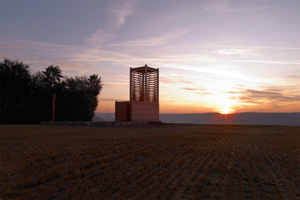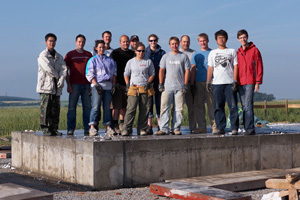
Some would call it a miracle. But for an IIT alumna, and a group of IIT students and their faculty mentor, it was an opportunity to build bridges and to touch the divine.
In January 2008, the Reverend Dankwart Moser-Feesche, a minister from the Odenwald/Bauland region of southern Germany, approached architect Dea Ecker (M.Arch. ’99) with his vision for an ecumenical chapel. Except for an idea about what the building would represent and where it should be located—in Boedigheim—he had no other resources to offer, not even the support of his congregation. Ecker immediately thought of Frank Flury, her longtime friend and IIT associate professor of architecture, who has established a far-reaching reputation for his unique Advanced Design/Build Studio course projects. Flury’s collaborative pro bono efforts have given his students invaluable hands-on experience and members of various communities the chance to enjoy new buildings, or rebuilt and improved structures.
“Frank’s studio has designed and built diverse projects in the United States that have had a positive social impact,” says Ecker. “The reverend’s chapel seemed to be viable possibility for the students at IIT to execute an international project for the first time.”

With Flury on board, Ecker explains, the multinational team took a “divide and conquer” approach in sharing responsibilities. During spring 2009, Flury and his 12 architecture students—from seven different states across the country and China—decided upon a design for the chapel and corresponded with Ecker’s firm, Ecker Architekten, via email, AutoCAD, and Skype teleconferencing to translate the design into a set of drawings that met or exceeded German construction standards. The reverend and local community members contributed to the project by acquiring property rights as well as accommodations for their American visitors. After Ecker’s office obtained the necessary building permits, the IIT team arrived in Germany in June to break ground and to build, with the help of local craftsmen, volunteer workers, and townspeople.
Ecker lives near the site and often drives by the Field Chapel, which is made entirely of wood obtained from the local forests; the structure is surrounded by four closed walls and has views open to the sky and the tower that comprises the sanctuary. She says she finds it remarkable that the IIT students were able to create such a special space of reflection and silence, whose sole occupant is light. She also thinks about another significant aspect of the building.
“The project has found positive resonance and a sense of pride and ownership in all of the participating municipalities; diverse groups have collaborated to create something not possible separately,” she says. “This means that the students, Reverend Moser-Feesche, Frank, and I were building more than a chapel. We were building bridges between neighbors within the community.”